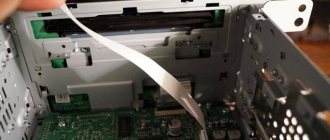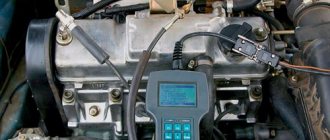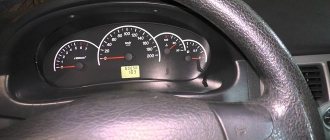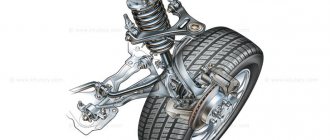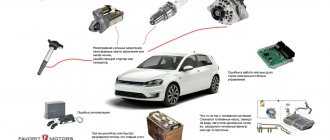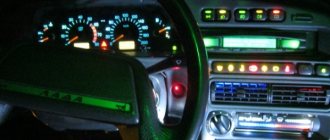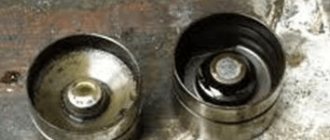Lada Priora is a family of cars from the Volzhsky Automobile Plant, which replaced the Lada 110 family of cars. Priora has been significantly improved and finalized. But, as with most domestically produced cars, problems very often arise with it. One of the most common problems is that the car does not pull.
Whether a car pulls or not depends on many factors, most of which relate to the operation of the power plant. Although there is also a possibility of failure of other mechanisms of the Lada Priora.
If the car breaks down and does not move at all, then you can turn to professionals and call a tow truck, for example, https://volok-evakuator.ru/shaxov.php.
Important: checking sensors
The answer to the question why the idle speed on a Priora fluctuates can often be this: one of the three sensors (IAC, TPS, MAF) is faulty. It's quite easy to check:
- Start the power plant.
- Disconnect the IAC power supply and analyze: the IAC frequency remains the same or the motor stalls - the sensor needs to be replaced. If the frequency has increased, the sensor is working.
- Restore power to the regulator.
- Remove the chip from the mass air flow sensor and observe: the speed has increased - the mass air flow sensor is working; the engine has stalled - the mass air flow sensor should be replaced.
- Connect power to the TPS.
- Disconnect the block from the mass air flow sensor and analyze: the crankshaft rotation speed has increased - the mass air flow sensor is working, the engine stalls - the throttle position sensor is faulty.
- Attach the chip to the mass air flow sensor.
Lada Priora idle speed fluctuates: reasons, repairs
In the case of the Priora, we have a 16-valve engine with an injector, which means with electronic fuel supply. You can often encounter a situation where the engine speed begins to “dance”, and sometimes the car even accelerates on its own, when there is not even any pressure on the gas pedal. Most often this happens when the engine is hot.
But this also happens at low temperatures, when in the morning, after starting the car, you can observe inadequate engine operation. In individual cases, interruptions may disappear on their own as the car warms up.
To begin with, it is recommended to diagnose the product to identify the root cause of the malfunction. The following points are worth considering:
- Is the engine filter clogged?
- Check the serviceability of the spark plugs.
- Condition of high voltage wiring.
- Make sure that the idle speed control and its electrics are in good working order.
- The oxygen supply sensor is faulty.
- Avoid damage to the temperature sensor.
- Is the on-board computer normal?
Causes of poor speed gain
General view of the engine under the hood
So, let's look at what the problem is and where exactly you need to look for it:
- Fuel pump and pressure.
- Injectors.
- Fuel rail.
- Ignition system.
- Electronic control unit.
Now that all the causes are predetermined, you can begin sequential diagnosis and methods for solving the problem.
Options for solving the problem
To diagnose all of the above systems you will need a set of wrenches and screwdrivers, a tester, a little knowledge and hands growing from the right place. The main task remains to correctly distribute the sequence of operations. This is exactly what we will talk about next. So, let's look at where we need to go to remove the effect that has arisen.
Fuel pump, filter, rail and injectors
Fuel pump in the process of disassembly and diagnostics
First of all, for diagnostics it is necessary to diagnose the gasoline module (pump). If the car drives at high speeds, then everything is fine with the pump itself, but the problem may lie in the filter mesh. For inspection, you will have to remove the fuel pump and replace the cleaning screen on it, which is primarily responsible for purifying gasoline. Most likely, it is dirty and needs to be replaced.
General view of the fuel filter
The second problem may be the fuel filter, which needs to be replaced. It is often dirty and needs to be replaced. After the first two elements of the fuel system have been replaced, you can try to drive it and see if the problem goes away.
General view of the fuel rail with injectors
If, nevertheless, the car continues to gain momentum poorly, then you need to crawl under the hood and look for the problem directly in the fuel injection system. To do this, you need to measure the pressure in the fuel rail.
To do this, dismantle the fuel rail with injectors and disassemble the assembly. The first element must be checked for leaks. Injectors are often installed on a special stand, cleaned and diagnosed. If necessary, all damaged elements are replaced.
Ignition
Unscrewing the spark plugs from the engine
If the fuel system has been checked and is working properly, then you need to look for a problem in the ignition system. So, the high-voltage wires are dismantled and the spark plugs are unscrewed. Both elements are checked using a tester. Of course, it is best to diagnose spark plugs on a special spark plug stand. As practice shows, the problem in 50% of cases lies precisely in this unit, so after checking it is necessary to replace the damaged elements. We conducted a special survey on the choice of candles.
Low quality fuel
At domestic gas stations, low-quality fuel is by no means uncommon. But even at branded gas stations you can buy low quality gasoline. As a result, the car will be difficult to start. The car will leave the gas station on the remaining old gasoline, and the engine will be warmed up. But after being idle, it will be quite difficult to start the car. There are several types of low-quality gasoline.
Fuel may be dirty: it may contain various deposits. They clog the fuel channels as well as the filters. As a result, the pressure in the fuel rail will be insufficient, and it will be very difficult to start the engine.
Gasoline can also be low octane. Most often, with such fuel, the car may not start when cold even the third time. You will hear the noise the engine is making, you will feel weak thrust, and detonation will occur. Experts do not recommend starting a car on this fuel.
To eliminate the cause, it is enough to drain the bad fuel and then flush the fuel system. Then you need to fill the tank with good gasoline.
Inspection of high voltage wire
Often, the Priora stalls when accelerating due to a malfunction of the ignition system. This is especially true for the condition of the high-voltage wire leading to the spark plug. To inspect it, you will need to remove the tip attached to the spark plug. The structure of a high-voltage wire is as follows: the winding contains the central core of the wire. The tip, which is put on the candle, has a persistent metal penny. The main purpose of this element is to transmit current to the spark plug.
The core of the high-voltage wire should fit as tightly as possible to the “penny” of the steel tip placed on the spark plug. Due to aging, contact between this element and the wire may be lost due to oxidation of the metal. As a result, tripling occurs. The oxidation of the contact is checked as follows: with the second probe of the multimeter, you should touch the central core of the high-voltage wire; if the core of the high-voltage wire burns out along its entire length, then it is possible to identify such a section using a special multimeter tip.
The wire is pierced until the affected area is identified every 5-10 mm. If such a section is detected, it is cut off if the length of the high-voltage wire allows it. Otherwise, it needs to be replaced.
Electrical and electronics
The cause of fluctuations in engine speed can be spark plugs whose brand or parameters (gap) are selected incorrectly. Perhaps they just need cleaning. Sometimes problems can occur due to a faulty (for example, cracked) ignition coil. Oxidized terminals of sensors, regulators or distributors require periodic cleaning or replacement.
Often, re-chipping (chipping) the car’s electronic system to a newer version helps, especially the systems of those models that have e-gas.
If the Priora stalls while driving, there may be the following reasons:
By the way, I recently read a forum, I forgot where - there this problem for Prior was discussed on 78 pages. A little operating advice - I recommend keeping the engine oil level at a medium level, and not at the maximum. The fact that the car stalled while driving did not bother him at all! And in services, garages, etc. Is this so, please advise, you won’t be constantly driving and braking at rpms of more than 2000...
5, started it - and as if nothing had happened, everything is ok! and yesterday, while coasting, it also stalled twice, what should I do, good people? I had this problem, but not on Prior.
Dear user, you have limited rights to publish topics and comments in the forums (banned). Should there be one coil on an eight-valve engine or a different one on a grant? I found somewhere on the net an advice to add two layers of heat-shrinkable tubing to the rubber insulator, it lasted for about a month, “knock on wood” and they don’t fly out.
Lada Priora sedan › Logbook › They float at cold speeds, warm up a little and everything is fine?
In general, it all started about three weeks ago. When starting in the morning, the revolutions rose to 1500, then 500 and the speed became normal, then slowly it got worse and worse, the lower the temperature and the longer the car sits, the longer the revolutions float, when you start in the morning, you have to keep on accelerating to keep it from stalling. Before that, when I didn’t apply the accelerator once, it blinked, and then the check light came on and started flashing. While I was traveling on business, the check went out, I went to the diagnostician, he said that there were misfires in cylinder 4. Maybe the coil is moving? Priora with an electronic pedal and throttle by the way!
In short, I found the reason, the rings on the receiver seemed to have fused, I replaced them with new ones and everything was fine!
Dips when pressing the gas pedal? Does the Priora have trouble starting?
Good day, if you are faced with a problem when you press the gas and the revolutions lazily increase and at the same time the car does not start the first time, then read the article. In most cases, the cause of this phenomenon may be a problem in the fuel system. Most likely, your fuel pump strainer is clogged or it’s time to change the fuel filter. In this article, we will take the Priora from the VAZ family as an example, and consider replacing the fuel filter. The fuel filter on a Priora must be replaced every 30,000 kilometers, as recommended by the manufacturer. The filter on the Prior is located under the fuel tank in the rear of the car, between the rear wheels. It is best to replace the filter in an inspection hole or in a suspended state.
To replace, we will need two keys for 12 and 10, as well as a Phillips screwdriver. We will need to decompress, which means removing excess fuel from the system. Remove the rear seat and unscrew the two bolts on the hatch using a Phillips screwdriver.
We unhook the connector from the fuel pump, start the engine and let it run until the fuel in the system runs out.
Loosen the filter fastening with keys 10 and 12. Remove the right pipe from the filter by pressing the latch and moving it to the side. Be sure to take a small container, as about 200-300 grams of gasoline will drain from the detached pipe.
Remove the second pipe by also pressing the latch and moving it to the side. Now you can remove the filter by tilting it down; not a lot of gasoline will drain from it either.
Installation of a new filter occurs in the reverse order. Be sure to install it strictly in the direction of the fuel, just like the old filter was. The filter has a fuel direction arrow, so it needs to be placed in the direction from the gas tank to the intake manifold
When installing the filter, you should also pay attention to the gaskets in the pipes for cracks and breaks.
Now that the filter is installed
We hook up the fuel pump terminal and, turning on the ignition without cranking the starter 2-3 times, pump gasoline into the system. We start the car and look for leaks at the junction of the fuel filter with the pipes. After making sure that there are no leaks, we put the fuel pump hatch cover and the rear seat back.
How to Avoid Failures
Having talked about how to eliminate gas pedal failures that occur on a car, it is worth talking about how to completely avoid their occurrence. So, the most common cause of their occurrence is wear of the spark plugs. Therefore, you should always check their condition, prevent clogging and oxidation, and, if necessary, replace them.
In addition to spark plugs, high-voltage wires should also be periodically monitored (despite the fact that they have a long service life, core breaks and breakdowns of protection are far from uncommon).
Another very common cause is clogged filters, and especially the air filter. This element is a direct participant in the chain of formation of the working mixture, and that is why its contamination (or even damage) can immediately affect the operation of the engine.
Gasoline for VAZ 2114
The last thing you should pay attention to in order to avoid unpleasant gas failures is the quality of the fuel. If you notice that at the nearest gas station it has dropped significantly (and the car reacts to this), then you should not continue to use it - it is better to try to refuel at a pump of another company (or several companies)
In this way, you can find the highest quality gas station and ensure reliable operation of your car’s engine.
Reason 5 – mass air flow sensor or ECU firmware
A malfunction of the mass air flow sensor on a Priora leads to the control unit receiving incorrect data on the amount of incoming air, as a result of which the air-fuel mixture is not prepared correctly, and the car may begin to twitch. The malfunction is determined using diagnostics at a service center.
The price of the sensor is not at all budgetary for a Priora - about 4,000 rubles. You can change it yourself. To do this, first disconnect the negative battery terminal, then the wire connector and unscrew the pipe clamp. After this, use a wrench to unscrew the two screws securing the air filter housing and carefully remove the sensor.
Inappropriate ECU firmware leads to the same symptoms. The air-fuel mixture is not prepared correctly, and interruptions may occur during engine operation. This can be caused by improper chip tuning or a malfunction of the “brains” themselves. In any case, only competent diagnosis will help here. It usually costs about 500 rubles. After diagnosis, the technician will tell you exactly how to solve the problem.
Ignition system
This is another fairly common option and the reason why the Priora has difficulty starting when cold. Almost regularly, due to sudden and constant temperature changes, various microcracks form in the ignition coils. When the coil heats up, it tends to expand. If there are cracks between the walls of the coil, then there is no hot breakdown, since the gap in the crack will be minimal. When it is cold, the microcrack will be larger and as a result there will be a breakdown. There will be no spark on the spark plug. There is no ignition of the mixture, the car does not start well.
The problem exists not only with the ignition coils, but with any other components that operate in the Priora ignition system. This could be a distributor, wires, spark plugs. In this case, there is nothing better than replacing the coil and other elements.
Low battery charge
If the Priora has an old battery installed, then in cold weather it discharges faster. This means that starting a cold engine in the morning can be problematic. Sometimes even a new battery drains quickly. In this case, you should look for current leaks. It may be in the wiring or the leak is occurring in some device.
If the search for current leakage does not produce results, then it is recommended to check how the generator charges the battery. If the charge is insufficient, then the battery will not charge fully. As a result, the starter will turn much harder than if the engine was cold.
Why is it stupid? Basic faults
Type of VAZ-2112 engine
There are not many reasons for the effect when the 16-valve engine on the VAZ-2112 16 valves stalls. Of course, you will have to tinker a little in order to find the true reason in one case or another, but otherwise there is a direct road to a car service center. For those who have decided to repair their car themselves, this information will be useful.
So, let's look at the main reasons for this effect:
We clean the sensor from dirt and dismantle it.
The main reasons are considered, and you can move on to solving these problems.
Methods for solving the problem
To eliminate failure during overclocking, you need to check all the components listed below step by step. This is a considerable amount of work, but the car enthusiast will be able to save a sufficient amount of money, which would have been charged to him at a car service center. Of course, for those who don’t understand the design of a car, that’s the way to go, or ask your friends who will fix the problems for half the price. But, if you follow the instructions, you can figure it out yourself.
Poor quality fuel
Poor quality fuel is a common cause of engine breakdowns
Of course, in our country, low-quality fuel causes many misfortunes and troubles for motorists. It is not possible to check the fuel at a gas station, so everyone is already struggling with the consequences. The only thing that can be done is to carry out regular diagnostics and cleaning of the fuel system.
Fuel system
Injectors on the fuel rail removed from the engine
The first line of engine protection is fuel filters, which sometimes fail and not enough fuel gets into the engine. On the other hand, when completely clogged, the injectors are clogged, which at low speeds give a normal amount of mixture, but if the engine is accelerated, the amount of mixture remains the same and a failure appears at low speeds.
The way out of the situation is to replace the fuel filter, clean or replace the gasoline pump mesh, and diagnose and replace failed injectors. The latter usually go through a cleaning stage, but this does not always help and they have to be replaced.
Throttle valve
Cleaned throttle body
A stuck throttle valve and insufficient air supply can cause the engine to become sluggish when accelerating. This is due to a non-optimal fuel mixture. In this case, the solution to the problem is cleaning.
VAZ 2110 troits engine
Engine problems, even episodic ones, always need to be addressed immediately. For example, it happens that at times the engine of a VAZ 2110 stalls, and many do not pay attention to this, continuing to operate the car as if nothing had happened. But this is the wrong attitude to this problem. Let’s look at the causes of this symptom and consider ways to quickly eliminate them.
When is it time to check the engine?
The engine should always run like a clock, that is, smoothly and without jerking, failures, or jumps.
At idle speed it is easy to notice that the engine is unstable. When such suspicions creep in, it is better to raise the hood and listen to the beats in all cylinders. “Troit” means one or two cylinders are inactive, since there are no conditions necessary to ensure the processes in their combustion chambers. As a result, the actual power of the power unit drops noticeably and gasoline consumption increases. There is also a tendency to stall, for example at intersections, at traffic lights or while warming up. At the same time, when the engine of a VAZ 2110 fails, the reasons for such a malfunction can be different. You can find out which cylinder has problems in one simple and long-known way. With the engine running, you need to remove the high-voltage wire from each spark plug one by one. If the cylinder was working properly before, then when it is turned off there will be a noticeable dip and a drop in speed (look at the tachometer scale). If there are no changes after removing the wire from the spark plug, we can safely assume that the problem is precisely in this cylinder - it was not working before the shutdown.
Causes of unstable motor operation
Here is an approximate and incomplete list of reasons for the “ten” engine tripping:
VAZ 2110 troits engine
- spark plug malfunction, getting wet;
- breakdown of a high-voltage wire;
- extremely low quality gasoline;
- air leaks in the vacuum brake booster system;
- loss of tightness in the area of the intake manifold;
- need for valve adjustment;
- valve or piston burnout;
- development of valve levers;
- breakage of piston rings;
- cylinder head gasket breakdown;
- deterioration or unsuitability of valve stem seals.
We will not dwell on all the points one by one, but it makes sense to note some methods for quickly identifying easily repairable breakdowns. So, for example, a non-working candle becomes an elementary problem. The same applies to broken armored wires. The easiest way to identify a malfunction is to replace each of these elements one by one with a known working one. It is also sometimes possible to notice sparking in the dark, which will indicate to you a damaged high-voltage wire.
There can be plenty of discussion about problems with valves, because such a “disease” is very typical for VAZ engines. First of all, we must not forget that every 10-20 thousand km the valves must be adjusted so that they are completely closed or opened during operation. But infrequent cases of valve and even piston burnout require accurate measurements of compression in the cylinders and subsequent opening of the power unit. In this case, the wear and tear of the piston rings is determined by pouring a small amount of engine oil into the cylinder - if the compression has increased, then the problem is most likely in the rings.
Loss of traction due to improper assembly or engine wear
Often the problem of power loss in a power unit is a mismatch between the position of the camshaft mark and the mark on the housing, which causes the engine's valve timing to be disrupted.
First, the alignment of the camshaft marks is checked. If the marks on the camshaft are in the correct position, you should also check the alignment of the marks on the crankshaft. Often a discrepancy in marks occurs precisely on it.
The classic way to start a broken car
Incorrect adjustment of the valve clearances of the gas distribution mechanism can also cause a loss of power from the power plant. If the gaps are incorrectly set, the valve timing is disrupted, which leads to a decrease in the power of the power plant. To eliminate the malfunction, check the valve clearances and, if necessary, make adjustments.
Finally, you should check the compression in the engine cylinders. If the compression rings are severely worn, the compression in the cylinders drops, which leads to a decrease in engine power. The malfunction is eliminated by replacing the rings.
Source
Common causes of floating revolutions
So, we figured out the main symptoms. Now let's move on to the reasons. Let us immediately note that floating idle speed is often a problem with injection engines. The fact is that a complex ECM system is responsible for idling in this case.
This system assumes the presence of a controller, sensors and actuators. The control unit receives signals from sensors and transmits commands to actuators (for example, IAC), maintaining stable engine speeds at idle and other modes, regardless of the load on the internal combustion engine.
Article on the topic: Disadvantages of the DSG gearbox: what you need to know
However, any failures that are associated with the supply of air, fuel, a violation of the composition of the working fuel-air mixture or its ignition, as well as various mechanical breakdowns will lead to floating speed.
It turns out that you should start checking with the throttle assembly, sensors and actuators. The ignition system, idle air regulator, mass air flow sensor also need diagnostics; it is necessary to assess the condition of the fuel and air filters, injection nozzles, etc.
As a rule, in practice, the idle air regulator causes a lot of problems for drivers. In fact, this is a stepper motor that has a conical locking needle. When the throttle valve is closed, air bypasses the valve through a channel that is closed by the needle.
If malfunctions occur in the operation of the device, the ECU is not able to correctly “select” the mixture composition at idle, as a result, the speed floats.
The mass air flow sensor also deserves special attention. During operation, the air flow sensor may become dirty or break down.
One way or another, the ECU does not receive correct data on air flow, which leads to disruption of mixture formation and jumps in engine speed.
Often, a floating engine speed can be associated with severe contamination of the throttle valve itself or mechanical breakdowns of the throttle, damage, or deformation. The damper may jam and not close completely.
To prevent such complications, it is necessary to periodically clean the throttle from dirt, and on many cars, additional training of the throttle is required after cleaning.
During diagnostics, you should also check the crankcase ventilation valves. Normally, crankcase gases are redirected to the intake, where they are mixed with air and fuel, after which they are burned in the cylinders.
On engines with mileage, a lot of crankcase gases accumulate due to natural wear and tear of the CPG. An excessive amount of such gases leads to a violation of the composition of the mixture if the crankcase ventilation valve jams. This is also a common reason why engine speed fluctuates.
By the way, if you touch on carburetor engines, the speed on the carburetor floats, usually due to the settings and adjustments of this device being messed up. Also, one should not exclude the possibility of a breakdown of the carburetor solenoid valve or clogging of the idle jet.
Let’s also add that if the speed of a diesel engine fluctuates, this is often caused by rust on the fuel injection pump blades. Corrosion occurs due to the presence of water in diesel fuel.
Jerks when moving
The moment the car starts moving, most often there is a failure. Unpleasant sensations are associated with a delay in the engine's response to pressing the accelerator pedal. In some cases, the engine stalls. A jerk occurs when the throttle valve opens, when, based on a signal from its position sensor, the ECU determines the moment of transition from cold mode to load mode. This is aimed at increasing the amount of fuel supplied through the injectors. Due to insufficient pressure in the fuel line, there is not enough fuel to move the Lada Priora smoothly.
For this reason, the car stalls when accelerating. In this case, the electronic control unit of the engine, having received a message from the throttle position sensor about the intensive opening of the damper at a large angle, strives to increase the fuel supply as much as possible. This is impossible to do due to low fuel pressure.
Why doesn't the engine rev up? Possible causes and methods of eliminating them
The engine does not pick up speed when you press the gas pedal: reasons
First of all, you need to pay attention to the “symptoms” of the problem: when it manifests itself, how, and whether there are additional signals indicating a malfunction. It is quite possible that the engine is fully operational and is being prevented from functioning normally by a sensor that was disconnected during repairs.
The technician can fix this problem after a short inspection.
If engine failures occur without any serious reasons, careful diagnostics are required.
Let's take a closer look at the reasons that the car owner can correct himself.
A key factor in reliable engine operation is the quality of the fuel mixture, the characteristics of its flow, ignition and combustion in the working area of the engine. Violation of any of the above processes leads to problems with engine speed
That is why, in case of failures in the internal combustion engine, the first thing you should pay attention to is the operation of the fuel and oxygen supply system
- If dirt, a mixture of oil and sand has accumulated in the air filter, air will penetrate into the engine unevenly, which will lead to a loss of engine power and, accordingly, to “missed” revolutions.
2. Malfunction of the intake system leads to excessive air leaks. The failure may occur suddenly, or it may become chronic. The intake of a large amount of air depletes the mixture, and there are too few flammable vapors in it. In this case, the engine starts, but during the trip the car cannot reach the required speed.
5.
6.
Correcting these problems is not difficult: you need to check whether the spark plugs and wires are sparking; look at the pressure level on the fuel rail pressure gauge; remove oily deposits and dirt from the air filter; change the fuel filter to a new one; clean the fuel pump screen, etc. from dirt deposits.
Engine speed may also drop for more complex reasons, which cannot be eliminated on your own, since repairs require special knowledge, experience and the availability of diagnostic equipment.
You cannot do without the help of a car service if:
- Failure in the timing of the car's gas distribution mechanism. If the timing of the engine is disrupted, the fuel intake and exhaust gases are uneven, and the valves open intermittently. A similar problem often arises after poor-quality repairs such as replacing the timing belt, improper valve adjustment, malfunctions of the valve timing system, and failure of the timing chain.
- Malfunction of the coils or ignition module. The main “sign” of this problem is that the engine begins to stall, misfires are observed in the cylinder system, and the number of revolutions decreases.
- Malfunctions in the power supply of the injector nozzles. The most common cause of this problem is poor wiring. The electrical signal does not reach the injector or does not reach it at the right time. Naturally, under such conditions, the injector cannot work correctly, which is why the fuel ignites unevenly in the cylinders, and engine power drops along with the speed.
- Problems with the fuel pump. An unpleasant breakdown that develops slowly but inevitably. As a result, the pressure created will not be enough to operate the engine: the engine will stall.
- Dirt getting into the injector. This problem can be caused by the use of low-quality fuel and contamination of the injectors. It is recommended to clean the injectors after 35-45 thousand km. mileage
- Unsatisfactory condition of the systems responsible for the removal of gases, primarily the USR, soot filters and catalyst. A large amount of carbon dioxide remains in the engine and the engine is not able to gain the required number of revolutions under such conditions.
- Failure of the electronic control system devices of the internal combustion engine, leading to a change in the composition of the combustible mixture.
- A breakdown of the electronic control unit cannot be ruled out. This problem can occur after poor-quality firmware repair. The main signal of a problem in the ECU is the jerky operation of the engine, an unexpected increase and drop in torque.
For a gas car, the correct settings of the engine and fuel supply system are key.
Priora doesn't work
Welcome to ChipTuner Forum.
Theme Options
Hello! There is a Priora 2010 onwards. engine 21126 (16 valves). ECU - M73 Itelma. 2 months ago the engine began to run rough (all cylinders are working, but there are periodic vibrations and uneven sound), loss of power, consumption increased. The ECU is flashed to euro2 (it has the original version with two oxygen sensors). It was stitched by the previous owner. There are no omissions, no errors either.
I saw two diagnosticians in the city.
The first diagnostician looked at the oscillograms and said that there were gas breakthroughs into the crankcase. He recommended trying to change the oil to 5w 40 and if nothing changes, then you can try additives from some company, of which he is an official representative))) He also checked the catalyst and said that at idle it seems like a bad catalyst, but at speed seems to be OK. He clarified that there may be cracks.
The second diagnostician looked and said that there were problems with the corrections (the adaptation parameter pxx and the additive component of self-learning correction). Apparently the mixture is poor and the injectors need to be cleaned. I cleaned it on his stand, all the corrections remained almost the same. The pxx adaptation parameter has become a little better.
what was done independently: changed the spark plugs (the spark plug on the second cylinder had a black velvety soot, and the new spark plug became completely black within a day), the air filter, cleaned the remote control, changed the mesh on the fuel pump. I bought Elm and began to look at the parameters myself. The following parameters are outside the tolerances: - average value of crankshaft rotation unevenness - 9.8 - additive component of self-learning correction - 15% - adaptation parameter pxx - 5-8% I also measured compression. 1 - 16, 5, 2 - 17, 3 -16, 4 -16. The mileage on the car according to the odometer is 99k, in reality it may be more. I’ve had the car in my hands since the mileage was 60k. At 80k there was a burnout in the piston (a year and a half ago). During the repair, we installed plug-free pistons of group E. After the repair, the car drove normally. There is oil consumption. I didn’t notice it in the city, but on the highway for 500 km it dropped by a third on the dipstick from the max mark. I don’t travel by car a lot (it’s about 2 km from home to work, with constant traffic jams). Consumption in such conditions is 14-15 liters - in the city, on the highway - 6 -7 liters (at a speed of 110 - 120). When the ignition is turned on, the DMRV ADC jumps from 1.011 to 1.025. Also on the second cylinder the latch on the coil chip is broken. Also in winter, the crankshaft sensor wire from the engine melted. I did some twisting, then heat shrinking, and then into the original corrugation and electrical tape on top.
Help me understand what’s wrong with the car))) I don’t want to spend money on repairs that will be of no use and expensive repairs. What's most interesting is what's wrong with the second cylinder. A plug with black velvet carbon, compression is higher than in other cylinders. There is smoke from the muffler when the gas is released, but it does not smoke at idle. Stuck oil rings?
Conclusion
Many car enthusiasts do not know the reasons for the high idle speed effect, much less how to eliminate it. So, of course, experts and car mechanics recommend contacting a car service straight away, but our man won’t stop until he tries it himself.
There are many reasons for the effect of increased speed, from faulty sensors to errors in the electronic control unit. You can also fix the problem at home, which is what owners of VAZs and other domestic cars do. But owners of foreign cars will have to contact a car service center, where repairs can amount to a considerable amount.

